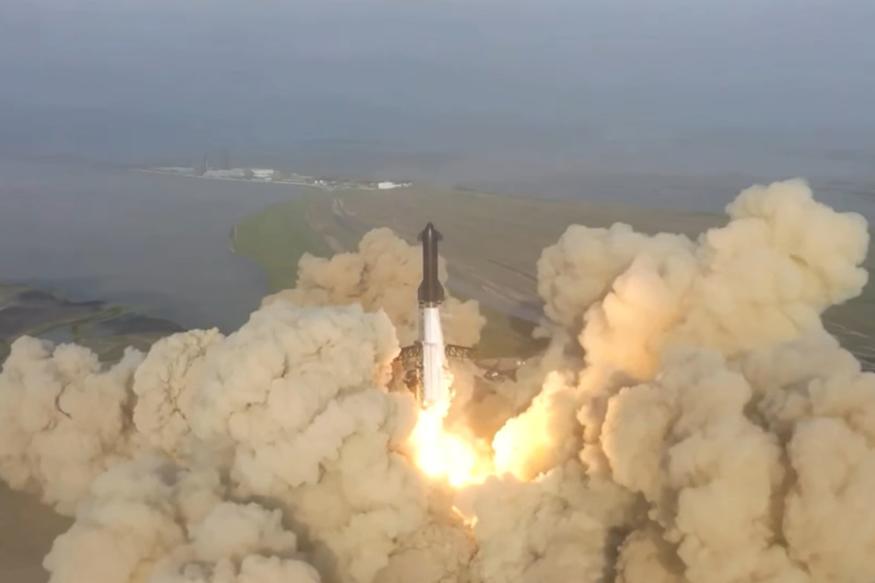Daily Feed
Launch of SpaceX’s Starship rocket ends in fiery explosion
Published
1 year agoon

Minutes after launching off from Boca Chica in South Texas, SpaceX’s Starship rocket exploded on Thursday. The rocket is the most powerful one ever built, and did not reach orbit, reaching a period of maximum aerodynamic pressure approximately a minute after launch, after which it began to tumble before exploding in a fireball high above the Gulf of Mexico.
SpaceX acknowledged that several of the Super Heavy’s 33 powerful Raport engines malfunctioned on ascent and that the booster rocket and Starship failed to separate as designed before the ill-fated flight was terminated.
<iframe title=”New York Times Video – Embed Player” width=”480″ height=”321″ frameborder=”0″ scrolling=”no” allowfullscreen=”true” marginheight=”0″ marginwidth=”0″ id=”nyt_video_player” src=”https://www.nytimes.com/video/players/offsite/index.html?videoId=100000008867597“></iframe>
But if experts are to be believed, there were many successful learnings for the private spaceflight company from this mission.
Successful failure, the Musk motto
The explosion was nothing less than spectacular, and only the latest example of Musk’s motto of failing fast, and reiterating quickly for success.
Traditional aerospace companies aim to minimise failures, a philosophy at odds with SpaceX’s Silicon Valley approach of failing quickly, and learning faster. When it tried to start landing Falcon 9 boosters, the first few hit too hard and exploded. With each attempt, SpaceX engineers tweaked the systems. After its first successful landing, more soon followed. Today, it is a rare surprise if a booster landing fails.
The company has precedence for this, taking a similar approach to fine-tuning the landing procedure for Starship. After earlier prototypes of Starship lifted off to an altitude of about six miles before shutting off its engines in an attempt to drop it through the atmosphere before firing its engines again for landing, a few of these attempts ended explosively before success was finally had.
Rather than seeing the fiery disintegration of the colossal, next-generation Starship system as a setback, SpaceX executives including Musk – the founder, CEO, and chief engineer of the California-based rocket company – were gung-ho about the test flight achieving its major objective of getting the vehicle off the ground while providing a wealth of data that will help accelerate Starship’s development.
Perhaps this failure was pre-empted, which is why the flight was unmanned, and flown almost entirely over water from the Gulf Coast Starbase facility in south Texas to avoid possible injuries or property damage on the ground from falling debris. Thus, with low consequences of any possible failure, one can understand why SpaceX sees it as a success rather than a massive misfire.
Perhaps the biggest impact of this SpaceX launch was the sheer cost of it. But for Musk, the world’s second-richest man with a net worth of $173.6 billion, this successful failure could well save money in the long-term as it helped more quickly identify flaws that need to be fixed, saving years of development time and costs in the process.
The large, complex rocket is the biggest one ever built by humankind, envisioned to carry more cargo and people to and from deep space than any spacecraft currently deployed. For context, NASA is currently on a mission to have the Mars Perseverance rover retrieve samples of Martian soil and minerals, which can be measured in kilograms. In comparison, Starship will carry back tons of rock, in addition to transporting dozens of astronauts and entire lab facilities to and from the moon and Mars.
Bill Nelson, a NASA administrator lauded the launch, saying that, “every great achievement throughout history has demanded some level of calculated risk, because with great risk comes great reward”.
Congrats to @SpaceX on Starship’s first integrated flight test! Every great achievement throughout history has demanded some level of calculated risk, because with great risk comes great reward. Looking forward to all that SpaceX learns, to the next flight test—and beyond. https://t.co/ZYsh5VkxsA
— Bill Nelson (@SenBillNelson) April 20, 2023
NASA is relying on SpaceX to build a spaceship that will carry two astronauts from lunar orbit to the surface of the moon during its Artemis III mission. With great anticipation surrounding the flight, Musk was quick to temper expectations, saying it might take several tries before Starship succeeds at this test flight. But while it might have ended in a fiery explosion, the four-minute-long flight would have provided invaluable data for engineers to understand the vehicle’s engineering and how it could be optimised further.
While the flight could not be dubbed a success, since the flight plan called for the spacecraft to reach a higher altitude of about 150 miles before splashing down in the Pacific Ocean near Hawaii about 90 minutes later, it represents a valuable learning experience. NASA, which is looking to have the first moon landing by astronauts aboard Starship by late 2025, will certainly hope those learnings can be quickly applied by SpaceX engineers.
SpaceX’s ultimate mission
Created to bring to life Musk’s ultimate vision of sending people to live on Mars some day, SpaceX’s ultimate goals could well end up being closer to home. With its load capabilities and reusability, it could well slash the cost of sending things to space, and enable new missions, such as exploring the cosmos and other planets. SpaceX is no stranger to this, with its rockets having already travelled to space 25 times in 2023.
The launch is another step towards SpaceX’s promise of making humanity multiplanetary, and could be dubbed a nominal success on account of providing valuable data and avoiding a worst-case outcome of exploding on the launchpad, which would have required extensive repairs.
Elon Musk offered his congratulations to the SpaceX team on Twitter as well.
Congrats @SpaceX team on an exciting test launch of Starship!
— Elon Musk (@elonmusk) April 20, 2023
Learned a lot for next test launch in a few months. pic.twitter.com/gswdFut1dK
Given the scale of the challenge, congratulations are well in order. Just as designing a skyscraper is exponentially more challenging than building a one-storey building, so it is too with designing a rocket of Starship’s scale, even more so when it is designed to be reusable and capable of launching again a few hours after landing. This is an engineering challenge that surpasses anything achieved in the history of the space age, and could herald an exciting time for humanity that could in time truly democratise space travel.
You may like
-


Indian Government’s Crackdown on Social Media: A Threat to Free Speech
-


The Simpsons did it again! This time foreseeing Apple’s latest technological innovation – The Apple Vision Pro
-


Dilip Venkatraman was promoted to SVP and business head for Media and Entertainment at Tech Mahindra
-


Swati Bhattacharya steps down as FCB India CCO
-


Lodha Ventures onboards Mahesh Shah as President of Corporate Communications
-


Nippon India Mutual Fund names Kaiyomurz Daver as Chief Marketing Officer


